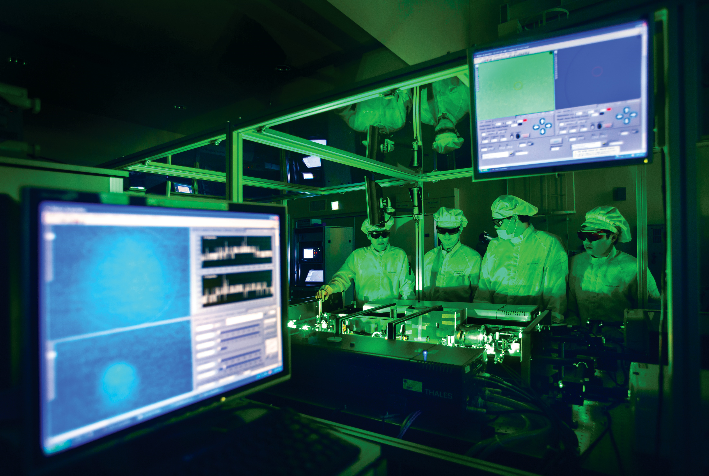Media Center
A multimedia mosaic of moments at GIST
GIST Excellence
GIST recognized as institute with the best research capabilities in Korea
- 김슬혜
- REG_DATE : 2014.03.28
- HIT : 896
GIST recognized as institute with the best research capabilities in Korea < National Research Foundation of Korea unveils “Report on the Comparison of Highly Cited Papers among Major Countries”> - In the ratio of top 1% citation, GIST ranks 1st (1.72%) among Korean institutes…higher than Kyoto Univ. (Japan) and Tsinghua Univ. (China) written by Korean lead author □ National Research Foundation of Korea announced the analysis result of research papers published by domestic research institutes and universities over the past 11 years (2002~2012) and Gwangju Institute of Science and Technology (GIST, President ž Young Joon Kim) came in 1st in the category of ‘Highly Cited Paper’. ○ ‘Highly Cited Paper’ refers to the ratio of the most cited research papers (top 1% globally) to the total number of SCI-level papers published by a research institute. ○ Papers of greater number of citations have more academic influence and draw more attention. A research institute with a higher ratio of ‘highly cited papers’ is said to have outstanding research capabilities and papers, thus exerts greater influence on academia. □ According to the “Report on the Comparison of Highly Cited Papers among Major Countries” unveiled by National Research Foundation of Korea on its homepage, GIST ranked 1st among domestic research institutes as 72 (1.72%) out of 4,178 SCI-level research papers published by its researchers in 2002~2012 were included in top 1% most cited papers in the world. ○ POSTECH (1.55%), Ehwa Women’s University (1.49%), Gyeongsang National University (1.34%) and Samsung Electronics (1.33%) occupied the 2nd ~ 5th slots on the list. (※ report download: National Research Foundation of Korea homepage [archive]-[research analysis report] http://me2.do/xxUhGofz) ○ In the ratio of Highly Cited Papers, GIST(1.72%) surpassed major universities in Asia, such as Tokyo University (1.66%) and Kyoto University (1.30%) of Japan, Tsinghua University (1.22%) and Chinese Academy of Science (1.23%) of China. □ GIST scored 58.33% in the ‘ratio of top 1% most cited papers written by Korean lead author’ and came in second among domestic research institutes. Among the 72 papers of GIST which were included in top 1% most cited papers, GIST’s researchers actively led research for 42 papers (58.33%) as lead author. □ For instance, Prof. Lee Kwang-hee of the School of Material Science and Engineering, GIST, who is reputed as the highest authority in the field of organic solar cells (he is also the Director of RISE) has published two research papers at the Science in 2007 and the Nature Photonics in 2009 respectively, and they were ranked 2nd (1,400 citations) and 4th (1,315 citations) in “top 10 most cited papers written by Korean lead author” (*2007, 2009: corresponding author) ○ If papers written by Korean co-authors are included, they rank 7th (in 2007) and 9th (in 2009) as the most cited papers in Korea. (* refer to the attachment for the contents of the papers) □ Papers written by GIST researchers ranked 1st as the most cited papers in Korea for 2 categories (material science, environment/ecology) in the survey on the “Most Cited Research Papers in 22 Categories in Korea” ○ Prof. Lee Kwang-hee’s research paper published in the Science (2007) was the most cited paper in the field of ‘material science’ in Korea and Prof. Choi Hee-cheol (School of Environmental Science and Engineering)’s paper published by the Environmental Science & Technology(ES&T) in 2005 was the most cited in the field of ‘environment/ecology’ (1st author basis). ○ Mr. Cheong Sung-ho, Head of the Office of Research, explained “GIST has only 6 divisions which intensively cover respective research fields. The fact that we produced the most cited research papers in 2 categories testifies to the success of the ‘selection and concentration’ research strategy employed by GIST over the past 20 years since its foundation.” □ President Kim Young-joon of GIST said “Last year, GIST ranked 6th in QS World University Rankings (number of citations per faculty) and 1st in QS Asia University Rankings (number of papers per faculty). Again, the research rankings announced by National Research Foundation of Korea proved the fact that GIST’s research capabilities and influence are of the highest level in Korea. As a small but strong university, GIST has provided various incentives to outstanding research outcomes and put premium on excellence of research results in evaluation. All of those efforts have boiled down to the highest quality of research today.” □ In the meantime, the number of top 1% most cited research papers in Korea was 2,483 papers during 2002~2012 and they accounted for 2.2% (or 15th ranking) of global top 1% most cited papers (112,558 papers). ○ During the same period, the ratio of top 1% most cited papers among SCI-level papers written by Korean researchers was 0.72%. ○ Korea’s share of top 1% most cited papers has continued to increase from 1.4% in 2002 to 3.2% in 2012.
- Prof. Lee Kwang-hee ranks 2nd & 4th in most cited papers
- GIST produces the most cited papers in 2 (material science, environment/ecology) out of 22 fields in Korea 